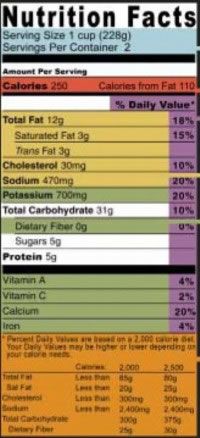Q. All of the terms on food labels are so confusing. How do I know what labels really mean?
A. Food label claims are not as straightforward as they may seem. For instance, a food labeled "Sugar Free" actually contains sugar, and foods labeled "Calorie Free" contain calories.
Here's a glossary of food label claims and what they really mean:
Advertisement
"Reduced," as in Reduced Sugar, Reduced Fat, Reduced Calories, Reduced Sodium, et al: Contains at least 25 percent less of the named offender than the regular version.
No Added Sugar: No sugars were added during processing.
Sugar Free: Contains fewer than 0.5 grams per serving.
Low Calorie: Contains 40 or fewer calories per serving.
Calorie Free or No Calories: Contains fewer than 5 calories per serving.
Light or Lite: Contains one-third fewer calories than the regular version, or less than 50 percent fat per serving.
Low Fat: Contains 3 grams or less fat per serving.
Fat Free: Contains fewer than 0.5 grams per serving.
XX% Fat Free: Based on the amount, by weight, of fat in 100 grams of the food. For example, a 100-gram serving of a food that is "97% Fat Free" would contain 3 grams of fat.
Low Cholesterol: Contains 20 mg or less cholesterol and 2 grams or less saturated fat per serving.
Cholesterol Free: Contains fewer than 2 mg of cholesterol and 2 grams or less of saturated fat per serving.
High Fiber: Contains 5 grams or more fiber and 3 grams or less fat per serving.
Good Source of Fiber: Contains 2.5 to 4.9 grams fiber per serving.
More Fiber or Added Fiber: Contains at least 2.5 grams more fiber per serving than the reference food.
Advertisement
